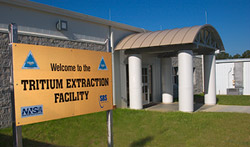
The Defense Nuclear Facilities Safety Board (DNFSB), an independent agency that provides oversight of DOE activities, notes more problems at the SRS tritium-handling facilities. SRS process and package all tritium, a radioactive gas produced in the two Tennessee Valley Authority TVA Watts Bar commercial reactors. It would seem that after so many years of operating that problems like this would not keep occurring.
The DNFSB has pointed out the health risks of possible tritium leakage at SRS. In spite of the chronic problems, the processing of tritium at SRS is significantly increasing as the US pursues a host of new nuclear warheads. The dangers of tritium exposure to SRS workers and the public and environment is another risk of the new US-Russia-China nuclear arms race that gets little attention.
DNFSB weekly report for November 29, 2024: https://www.dnfsb.gov/sites/default/files/2025-01/Savannah%20River%20Week%20Ending%20November%2029%202024.pdf
Savannah River Tritium Enterprise (SRTE): The facility declared a TSR violation due to
Material Test Facility (MTF) personnel failing to properly manage a tritium storage container.
During a routine surveillance, a technician discovered that the tritium filled container was
leaking into its credited secondary container and appropriately stopped, placed the plant in a safe
configuration, and informed reservoir engineering personnel. Management contacted the design
agency, who recommended that the unit be unloaded. MTF personnel did not enter the limiting
condition for operations (LCO) for a non-robust container upon suspending the procedure or re-
establish the inert atmosphere by flushing and backfilling the secondary container prior to
removing the container from the testing apparatus as required by procedure. In addition, workers
subsequently violated the TSRs two additional times when they moved the container from the
hood to a glovebox without following the requirements prescribed in the secondary container
controls and empty container verification specific administrative controls. These controls are
credited to limit the oxygen concentration and amount of tritium released to prevent an explosion
and to limit the radiological consequences. The facility is in the LCO for non-robust containers,
which requires the non-robust container be placed in a secondary confinement system or
qualified secondary containers within 7 days. SRTE management developed a response plan to
transfer the container to a credited glovebox in H-Area New Manufacturing. Management has
put the surveillance procedure on administrative hold and will conduct a root cause analysis and
develop corrective actions.
SRTE declared another TSR violation when radiological controls personnel discovered during
daily rounds in the Tritium Extraction Facility that the sample inlet valve to a credited tritium air
monitor (TAM) was in the incorrect position, which prevented its operation. Investigation
revealed that operators left the valve in the “background” position rather than the “sample”
position following a monthly surveillance completed two days prior to the discovery. The
procedurally required independent verifier for the surveillance and a radiological control
inspector (RCI) performing daily rounds the next day both failed to identify that the valve was in
the wrong position. Two other credited TAMs were functional in the room during this time
period and neither recorded any abnormal activity levels. The investigation team identified
operators not using a flashlight in poor lighting conditions, complacency, and
insensitivity/inadequate level of knowledge of the RCI as the initial causes. The facility is
conducting a root cause analysis of the event.
DNFSB weekly report for November 22, 2024: https://www.dnfsb.gov/sites/default/files/2025-01/Savannah%20River%20Week%20Ending%20November%2022%202024.pdf
Savannah River Tritium Enterprise (SRTE): SRTE management instituted a requirement for
senior supervisory observers to be present for all gas transfers in after multiple operational errors
over the last few weeks. In one instance, CROs were completing separate procedures but
utilizing a common evacuation header. Due to poor communication and procedure quality
issues, a CRO opened an isolation valve that aligned waste gas to the loading line, which
potentially impacted the loading evolution. In another situation, a CRO conducting gas
movements blew a protective rupture disk when they operated valves outside of the approved
procedure. In addition to these gas transfer issues, SRTE also held an issue investigation
meeting regarding operators selecting the incorrect timing for a gas transfer system function test
and are working through corrective actions related to a construction worker stepping on and
breaking a process pipe during open glovebox maintenance.
DOE photo: tritium canister filled at SRS and inserted into a nuclear warhead. Note there is no scale as its size is classified.